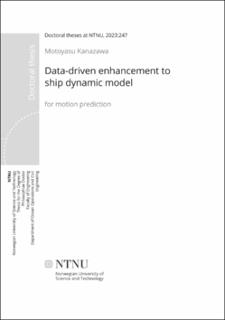| dc.contributor.advisor | Zhang, Houxiang | |
| dc.contributor.advisor | Li, Guoyuan | |
| dc.contributor.author | Kanazawa, Motoyasu | |
| dc.date.accessioned | 2023-09-08T11:22:04Z | |
| dc.date.available | 2023-09-08T11:22:04Z | |
| dc.date.issued | 2023 | |
| dc.identifier.isbn | 978-82-326-7193-9 | |
| dc.identifier.issn | 2703-8084 | |
| dc.identifier.uri | https://hdl.handle.net/11250/3088275 | |
| dc.description.abstract | Ensuring safety and efficiency is the most critical agenda for the maritime industry. It is essential to have a good understanding of ship dynamics and make accurate predictions of ship motion. This enables us to properly evaluate risks such as collision and excessive motion. The bedrock to do so is to develop advanced ship dynamic models for making accurate motion predictions.
Ships are complex systems composed of multi-scale and multi-disciplinary sub-systems, such as a hull, thrusters, engines, etc. They are exposed to external disturbances such as wind, waves, and ocean currents in real-world sea conditions. These complexity and non-linearity lead to strong uncertainties in dynamic models, making it difficult to achieve high performance. The maritime industry has faced increasingly rigorous cost requirements, leading to a demand for a more agile framework for delivering dynamic models.
To address this, this dissertation proposes a framework that makes a synergy of two modeling principles. Physics-based modeling has played a dominant role, emphasizing a mechanical understanding of ship motion. The resulting model is accompanied by physical interpretations and is trusted by experts for their knowledge foundation and reliability. The flip side of its physics-based inspiration is that it tends to perform poorly on the full-scale dataset of interest. Moreover, it requires much expertise and meticulous experiments, resulting in high costs in both time and resources. On the other hand, data-driven modeling aims to learn inductively hidden patterns from full-scale data. It excels at handling strong non-linearity and complexity. With the use of cutting-edge machine learning models that are robust to noise and disturbances, it is possible to effectively utilize onboard data for better ship dynamic models. However, due to their poor interpretability, replacing the strong aspects of physics-based models with them would not be a good idea.
Two modeling principles play different roles and cannot be replaced by each other. Instead, in the agile framework, they need to leverage each other's strengths for complementing each other's weaknesses. To this end, this dissertation develops a framework in which data-driven models enhance the performance of the physics-based model while receiving sufficient knowledge transfer and continuity from the physics-based model. New techniques are presented in four case studies for various pragmatic problems where full-scale data needs to rapidly benefit the performance of the physics-based model. The comprehensive experimental study addresses how the physics-based model and data benefit the enhanced performance in such a framework. A novel method is also presented to bridge the dynamics of similar ships and ease model development. This dissertation proposes specific enablers of such a framework that enhances physics-based models with data-driven methods and demonstrates its promising effectiveness through simulation and real-world validation experiments. | en_US |
| dc.language.iso | eng | en_US |
| dc.publisher | NTNU | en_US |
| dc.relation.ispartofseries | Doctoral theses at NTNU;2023:247 | |
| dc.relation.haspart | Paper 1: Kanazawa, Motoyasu; Skulstad, Robert; Li, Guoyuan; Hatledal, Lars Ivar; Zhang, Houxiang. A multiple-output hybrid ship trajectory predictor with consideration for future command assumption. IEEE Sensors Journal 2021 https://doi.org/10.1109/JSEN.2021.3119069 | en_US |
| dc.relation.haspart | Paper 2: Kanazawa, Motoyasu; Hatledal, Lars Ivar; Li, Guoyuan; Zhang, Houxiang. Co-simulation-based Pre-training of a Ship Trajectory Predictor. I: Software Engineering and Formal Methods. SEFM 2021 Collocated Workshops. Conference proceedings © 2022. Springer https://doi.org/10.1007/978-3-031-12429-7_13 | en_US |
| dc.relation.haspart | Paper 3: Kanazawa, Motoyasu; Skulstad, Robert; Wang, Tongtong; Li, Guoyuan; Hatledal, Lars Ivar; Zhang, Houxiang. A Physics-Data Co-Operative Ship Dynamic Model for a Docking Operation. IEEE Sensors Journal 2022 ;Volum 22.(11) s. 11173-11183 https://doi.org/10.1109/JSEN.2022.3171036 | en_US |
| dc.relation.haspart | Paper 4: Kanazawa, Motoyasu; Wang, Tongtong; Skulstad, Robert; Li, Guoyuan; Zhang, Houxiang. Knowledge and data in cooperative modeling: Case studies on ship trajectory prediction. Ocean Engineering 2022 ;Volum 266.(4) https://doi.org/10.1016/j.oceaneng.2022.112998 This is an open access article under the CC BY license | en_US |
| dc.relation.haspart | Paper 5: Kanazawa, Motoyasu; Wang, Tongtong; Ichinose, Yasuo; Skulstad, Robert; Li, Guoyuan; Zhang, Houxiang. Bridging similar ships’ dynamics for safeguarding the system identification of maneuvering models. Ocean Engineering 2023 ;Volum 280. https://doi.org/10.1016/j.oceaneng.2023.114874 This is an open access article under the CC BY license | en_US |
| dc.relation.haspart | Paper 6:
Kanazawa, Motoyasu; Wang, Tongtong; Skulstad, Robert; Li, Guoyuan; Zhang, Houxiang
Physics-data cooperative ship motion prediction with onboard wave radar for safe operations | en_US |
| dc.title | Data-driven enhancement to ship dynamic model for motion prediction | en_US |
| dc.type | Doctoral thesis | en_US |
| dc.subject.nsi | VDP::Technology: 500::Marine technology: 580 | en_US |

